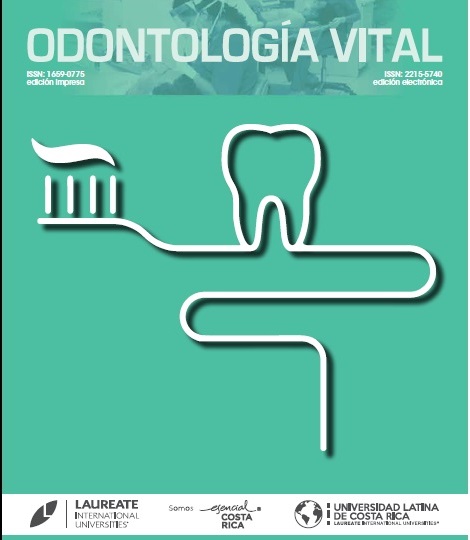Buffer capacity of saliva and its relation to the prevalence of caries, with the intake of different commercial drinks
Based on the research: Analysis of the buffer capacity of saliva before the intake of different types of beverages (soda, natural juices based on fruit and commercially available sugar juices) and its relation to the prevalence of caries according to ICDAS in children of 4 to 10 years of age of the San Jorge Catholic Education Center in Abangares, Guanacaste, between May and December 2016.
DOI:
https://doi.org/10.59334/ROV.v2i31.330Keywords:
Prevalence of caries, buffer capacity, dental pH, healthy and unhealthy foods, ICDAS, pediatric dentistryAbstract
Nowadays the consumption of juices, and soft drinks, is very common in the children’s diet, they offer different flavours and a high content of sugar. In this study, an analysis of the buffer capacity of the saliva was made in view of the intake of different types of beverages considered healthy and unhealthy. Two types of instruments were used, a clinical test applied to 62 students to determine the prevalence of caries according to ICDAS and a second instrument that consists of a chart applied to the same 62 students with the purpose of analyzing the buffer capacity by taking the pH on intervals of 15, 35 and 45 minutes after drinking the beverages.
As a conclusion, it was obtained that for the drinks considered unhealthy, the pH took longer to neutralize, while the healthy drink achieved its neutralization faster, with a low prevalence of caries.
Downloads
References
Aguirre, A.; Narro, F. (2016). Perfil salival y su relación con el índice CEOD en niños de 5 años. Revista Odontológica Mexicana, 20 (3), 159-165. https://doi.org/10.1016/j.rodmex.2016.08.002
Aguirre Aguilar, A. A; & Rebaza Honores, M. L. (2014). Perfil salival de niños de 5 años libres de caries y su relación con el nivel de placa dentobacteriana. Revista Oral, 15(49), 1173-1178.
Barrios, C.; Martínez, S.; Encina, A. (2016). Relación de los niveles de caries y pH salival en pacientes adolecentes. RAAO, 4(1), 41-48. Recuperado de http://www.ateneo-odontologia.org.ar/articulos/lv01/articulo5.pdf
Bellet, L.; Barroso, J.; Guinot, F.; Barbero, V. (2011). La importancia de la dieta en la prevención de la caries. Recuperado de http://www.gacetadental.com/2011/09/la-importancia-de-la-dieta-en-la-prevencin-de-la-caries-25430/
Cerón, X. (2015). El sistema ICDAS como método complementario para el diagnóstico de caries dental. Revista CES Odontología, 28 (2), 100-109. Recuperado de http://revistas.ces.edu.co/index.php/odontologia/article/view/3680/2491
Cosí Arévalo, D. J., Ortega Cambraris, A., & Vaillard Jiménez, E. (2010). DETERMINACIÓN DE EL PH SALIVAL ANTES< DURANTE Y DESPUES DE EL CONSUMO DEL CARAMELO EN NIÑOS Y NIÑAS DE 3,4,Y 5 AÑOS DE EDAD. Revista Oral, 11(S2), 52-53.
González, A.; González, B.; González, E. (2013). Salud dental: relación entre la caries dental y el consumo de alimentos. Nutrición Hospitalaria, 28(4), 64-71. Recuperado de http://www.redalyc.org/articulo.oa?id=309227005008
Hernández, A.; Aránzazu, G. (2012). Características y propiedades fisicoquímicas de la saliva: una revisión. Recuperado de http://www.researchgate.net/publication/273004055_Caracteristicas_y_propiedades_fisico-quimicas_de_la_saliva_una_revision
Loyo, K.; Balda, R.; González, O.; Solórzano, A.; González, M. (1999). Actividad cariogénica y su relación con el flujo salival y la capacidad amortiguadora de la saliva. Acta odontológica venezolana. Obtenido de http://www.actaodontologica.com/ediciones/1999/3/actividad_cariogenica_relacion_flujo_salival.asp
Moreno, J.; Galiano, M. (2015). Alimentación del niño preescolar, escolar y del adolescente. Pediatría Integral. 19(4), 268-276. Recuperado de http://www.pediatriaintegral.es/wp-content/uploads/2015/07/Pediatria-Integral-XIX-4_WEB.pdf#page=45
Nasco, N.; Gispert, E.; Roche, A.; Alfaro, M.; Pupo, R. (2013). Factores de riesgo en lesiones incipientes de caries en niños. Revista Cubana de Estomatología, 49(2), 142-152. Recuperado de http://scielo.sld.cu/pdf/est/v50n2/est02213.pdf
Ortiz, L.; Gutiérrez, M.; Medina, K.; Chein, S. (2007). Eficacia de una medida preventiva para el niño con riesgo cariogénico asociada a la estabilidad de pH salival. Odontología Sanmarquina, 10 (1), 25-27. https://doi.org/10.15381/os.v10i1.2924
Puy Llena, C. (2006). La saliva en el mantenimiento de la salud oral y como ayuda en el diagnóstico de algunas patologías. Recuperado de http://scielo.isciii.es/scielo.php?pid=S169869462006000500015&script=sci_arttext1q
Saha, S., Jagannath, G. V., Shivkumar, S., & Pal, S. K. (2011). EFFECT OF COMMONLY CONSUMED FRESH FRUIT JUICES AND COMMERCIALLY AVAILABLE FRUIT JUICES ON pH OF SALIVA AT VARIOUS TIME INTERVALS. Journal of International Dental & Medical Research, 4(1), 7-11.
Sheiham, A., & James, W. T. (2015). Diet and Dental Caries: The Pivotal Role of Free Sugars Reemphasized. Journal of Dental Research, 94(10), 1341-1347. https://doi.org/10.1177/0022034515590377
Saxena, F. (2015). Principios básicos de odontología para el pediatra. 1 Parte. Revista Boliviana de pediatría, 54 (1), 50-54. Recuperado de http://www.scielo.org.bo/scielo.php?pid=S1024-06752015000100010&script=sci_arttext&tlng=es
Simón-Soro, A., & Mira, A. (2015). Solving the etiology of dental caries. Trends In Microbiology, 23(2), 76-82. https://doi.org/10.1016/j.tim.2014.10.010
Tadakamadlaa, J.; Kumar, S.; Ageeli, A.; Venkata, N.; Babu, M. (2015). Enamel solubility potential of commercially available soft drinks and fruit juices in Saudi Arabia. The Saudi Journal for Dental Research, 6 (2), 106-109. https://doi.org/10.1016/j.sjdr.2014.11.003
United States Department of Agriculture. (2011). Reduzca el consumo de golosinas de sus hijos. [16-08-16]. Recuperado de http://www.choosemyplate.gov/sites/default/files/tentips/DGTipsheet13CutBackOnSweetTreats-sp.pdf
Downloads
Published
Issue
Section
License
Copyright (c) 2019 María Fernanda Sáenz Masís, Daniela Madrigal López

This work is licensed under a Creative Commons Attribution 4.0 International License.
Authors who publish with Odontología Vital agree to the following terms:
- Authors retain the copyright and grant Universidad Latina de Costa Rica the right of first publication, with the work simultaneously licensed under a Creative Commons Attribution 4.0 International license (CC BY 4.0) that allows others to share the work with an acknowledgement of the work's authorship and initial publication in this journal.
- Authors are able to enter into separate, additional contractual arrangements for the non-exclusive distribution of the Odontología Vital's published version of the work (e.g., post it to an institutional repository or publish it in a book), with an acknowledgement of its initial publication.
- Authors are permitted and encouraged to post their work online (e.g., in institutional repositories or on their website) prior to and during the submission process, as it can lead to productive exchanges, as well as earlier and greater citation of published work.







